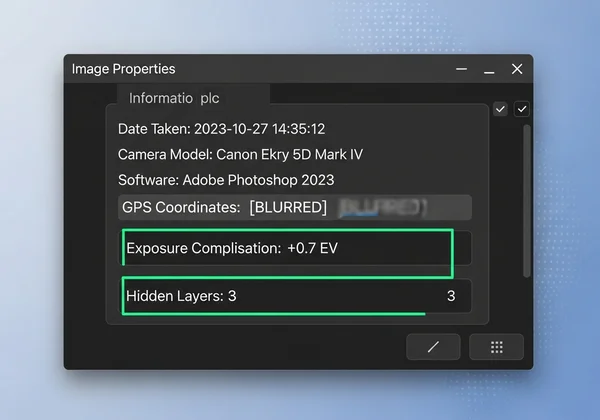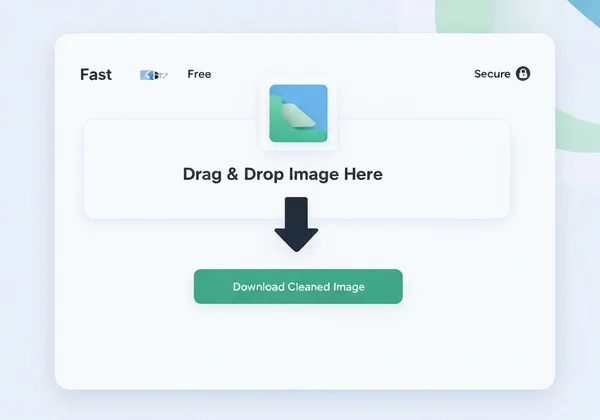What Your Photos Reveal: A Guide to Hidden EXIF Data and Metadata Removal
Every time you share a photo, you're sharing a story. But what if that photo is telling a second, hidden story you never intended to reveal? Many people don't realize that their innocent pictures contain a treasure trove of hidden data. This guide will pull back the curtain on what metadata reveals and show you how to protect your privacy. What is metadata in a photo, and why should it matter to you?
This hidden information, often called EXIF data, can expose sensitive details about you, your family, and your habits. It’s like leaving a digital breadcrumb trail with every picture you post online. Before you share your next memory, let's explore this hidden world and learn how you can easily protect your privacy with a few simple clicks.

What's Hidden in Your Photos? Understanding Metadata's Secrets
At its core, metadata is "data about data." For a digital photo, this means all the background information that your camera or smartphone automatically embeds into the image file. This isn't just basic file information; it's a detailed log of how, when, and where your photo was taken. Let’s break down the most common types of information that are hiding in plain sight.
Unmasking EXIF Data: Beyond Basic Image Information
EXIF, which stands for Exchangeable Image File Format, is the most common standard for photo metadata. Think of it as your photo’s digital ID card. It contains technical details that are useful for photographers but can be overly revealing for everyday sharing. This includes:
- Camera Settings: Shutter speed, aperture, ISO speed, and focal length.
- Software Used: Information about the program used to view or edit the photo, like Adobe Photoshop.
- Copyright Information: Notes added by the creator.
While these details might seem harmless, they are just the tip of the iceberg. The real privacy concerns arise from the more personal data points that are often included without your knowledge.
Geographic Tags: Pinpointing Your Every Location (GPS Data)
The most sensitive piece of metadata is often the GPS coordinates. If your camera or smartphone has location services enabled for the camera app, every single photo you take is tagged with the precise latitude and longitude of where it was shot. Sharing a photo taken at home could inadvertently broadcast your home address to the world. A picture from your child's park could reveal their daily playground. This data makes it frighteningly easy for someone to track your movements and map out your life.
Camera & Device Info: Who Shot It, What They Used
Your photos also carry a digital signature of the device used to capture them. This includes the make and model of the camera or smartphone, such as a "Canon EOS R5" or an "Apple iPhone 15 Pro." In some cases, it can even include the unique serial number of the device. This information can be used to link different photos from various platforms back to a single individual, creating a more detailed profile of you than you might be comfortable with.
Date & Time Stamps: Documenting When the Moment Happened
Every photo you take is stamped with the exact date and time it was created. While this is great for organizing your personal albums, it can be a privacy risk when shared publicly. A series of photos can reveal your daily routine, when you're typically at home, or when you're away on vacation. This kind of information, when combined with location data, can create significant security vulnerabilities.
See for Yourself: A Practical EXIF Data Example
Talking about metadata is one thing, but seeing it for yourself is another. It's surprisingly easy to find metadata in photo files you already have. This simple exercise can be an eye-opening experience that demonstrates the reality of digital exposure.
Step-by-Step: How to Find Metadata in Your Photos
You don't need special software to view basic EXIF data. Here’s how to do it on most computers:
- On Windows: Right-click on an image file, select "Properties," and then click on the "Details" tab. You'll see a list of data fields, from the camera model to GPS coordinates, if they exist.
- On macOS: Open a photo in the Preview app. Go to "Tools" in the menu bar and select "Show Inspector." Click on the "EXIF" tab (it may look like an "i" in a circle) to see the hidden data.
Try this with a few photos from your phone. You might be shocked at how much information is readily available.

Visual Breakdown: Annotated Photos Reveal All Their Secrets
To give you a clearer picture, let's create a mental exif data example. Imagine a beautiful photo of a golden retriever playing in a backyard, which you just posted on social media.
- What You See: A happy dog enjoying the sun.
- What Metadata Reveals:
GPS Location: 40.7128° N, 74.0060° W(Pinpoints the exact backyard).Date/Time: 2023-10-26, 15:30:00(Shows you were home on a Thursday afternoon).Device: Google Pixel 8 Pro(Identifies the phone you own).Image ID: IMG_20231026_153000.jpg(A unique file name that could be tracked).
This single photo has revealed your location, your schedule, and the technology you use. Now that you've seen the proof, it's easy to understand why you should remove picture metadata before sharing.
Why Should You Care? The Real Risks of Exposed Photo Metadata
Understanding the risks is the first step toward protecting yourself. Exposed metadata isn't just a theoretical problem; it has real-world consequences for your privacy, safety, and even professional life. It's crucial to understand why remove metadata from images is no longer optional but essential in today's digital age.
Protecting Your Privacy: From Identity to Personal Security
In the wrong hands, the information embedded in your photos can be used for malicious purposes. Stalkers can use GPS data to find you. Burglars can use timestamps from your vacation photos to know when your house is empty. Bit by bit, this data can be pieced together to build a detailed profile for identity theft or targeted harassment. Stripping this data is a fundamental step in protecting your personal security.
Child Safety: The Dangers of Sharing Too Much Online
For parents, the stakes are even higher. A simple photo of your child at a birthday party could reveal the location of a friend's home. A first-day-of-school picture taken on your front porch could expose both your home address and your child's school. Protecting children online means being vigilant about the invisible data we share. A simple meta cleaner can help safeguard your family's location and routines.

Professional & Compliance Risks: Avoiding Unintended Data Leaks
The risks extend beyond personal sharing. For professionals like photographers, real estate agents, or journalists, accidentally leaving metadata in photos can have serious consequences. A photographer could leak a client's private location, while a corporation could violate data privacy regulations like GDPR by publishing photos with embedded employee or customer data. Businesses can use our meta cleaner to ensure all published images are compliant and safe.
Taking Control: How to Remove Image Metadata Easily
Now that you understand the problem, the good news is that the solution is incredibly simple. You don't need to be a tech expert to remove image metadata and secure your photos. With the right tool, you can make your images safe for sharing in just a few seconds.
The Simple Online Solution: Fast, Free, and Secure Metadata Removal
The easiest way to protect your privacy is with a dedicated tool designed for this exact purpose. Our online metadata remover provides a fast, free, and secure solution to strip all hidden data from your images. Our core advantages include:
- Ultimate Security: We never store your images. All processing happens instantly, and your photos are immediately deleted from our servers.
- Simplicity: The process is as easy as drag, drop, and download. No software installation or registration is required.
- Speed: The entire process takes only a few seconds.
- Free Access: Our powerful tool is completely free to use.
This is the perfect online metadata remover free of charge and free of hassle. Ready to secure your photos? Try our free tool right now.

Your Privacy, Your Choice: A Quick Step to Digital Protection
Taking control of your data empowers you to share content on your own terms. By removing metadata, you decide what information goes public. It's a simple, proactive step that enhances your digital protection and gives you peace of mind. Making this a regular habit before posting online is one of the smartest moves you can make for your digital privacy.
Your photos are meant for sharing memories, not your personal data. An innocent post can quickly become a privacy risk due to the hidden world of metadata. But now that you know what's lurking beneath the surface of your images—from your precise location to your daily habits—you have the power to take action.
Don't let your digital footprint betray you. Empower yourself by making metadata removal a standard part of your sharing routine. It's fast, easy, and one of the most effective ways to protect yourself and your loved ones online. Take control of your digital privacy today. Remove metadata from photo safely and securely before you share your next picture.
Frequently Asked Questions About Photo Metadata
What exactly is metadata in a photo?
Metadata is the hidden text information embedded within an image file. It includes details like the date, time, and GPS location where the photo was taken, as well as the camera model, settings, and sometimes even the device's serial number.
Why is removing metadata from images important for my privacy?
Removing metadata is crucial because it prevents you from unintentionally sharing sensitive personal information. This data can reveal your home address, workplace, daily routines, and children's locations, posing risks of stalking, theft, or other privacy invasions.
How can I delete EXIF data from my pictures?
While some operating systems have built-in tools, they can be clunky and time-consuming. The simplest and quickest method is to use a dedicated online tool. Our exif remover allows you to upload your photo, automatically strips all EXIF data in seconds, and lets you download the clean image instantly.
Is it safe to use an online metadata remover tool?
Safety is paramount, which is why it's essential to choose a trustworthy tool. At our trusted online tool, we prioritize your privacy above all else. We process your images on the fly and never save or store them on our servers, ensuring your data remains completely confidential.
What kind of personal details can metadata reveal about me?
Metadata can reveal a surprising amount. Primarily, it can show exactly where you were (GPS), when you were there (date/time), and what device you use. Over time, this can be aggregated to map out your life patterns, such as where you live, work, and spend your leisure time.